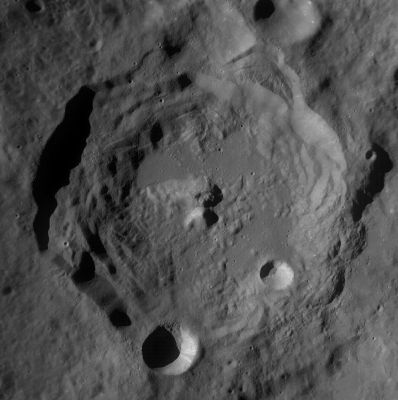O'Day
Contents
O'Day
|
Lat: 30.62°S, Long: 157.5°E, Diam: 72.66 km, Depth: 5.6 km, Rükl: (farside), Copernican |

LROC image WAC No. M118823820ME. Calibrated by LROC_WAC_Previewer.
Images
LPOD Photo Gallery Lunar Orbiter Images Apollo Images
LO-II 075 h3 is a HiRes scan of Lunar Orbiter II's detailed photograph of O'Day (upper part of photograph, south up), with a curious elongated depression near the photograph's lower left corner (called Barbier K)(according to LAC 103 in the Clementine Atlas of the Moon).
Additional research: Danny Caes
Maps
Description
Wikipedia
Additional Information
- IAU page: O'Day
- Originally mapped as Copernican because it has rays but these are compositional rays (highlands material) thatt have reached full optical maturity and thus are older than Copernicus; O'Day is Eratosthenian age. (Hawke et al: Composition and origin of Copernican Rays… Mappers Conference 2005).
- Maximum depth read from LM map; seems too deep.
- Central peak composition: A, GNTA1 & GNTA2 (Tompkins & Pieters, 1999)
- Exterior impact melt deposits most extensive to ESE, max of ~30 km beyond rim. Most extensive ejecta, rays and secondary craters to the SE, with max wall slumping on W side of crater, and topographically lowest rim crest to SE (Hawke and Head, 1977).
Nomenclature
Marcus Driver O'Day (1897 – 1961) was an American physicist. In 1946 and 1947 he guided a team that worked to launch scientific payloads into the ionosphere using V-2 rockets. He would theorize in 1958 that solar power could be used to sustain a colony on the Moon, and hypothesized that there may be water under the lunar surface.
LPOD Articles
Bibliography
Named Features -- Prev: Obruchev -- Next: Lacus Odii